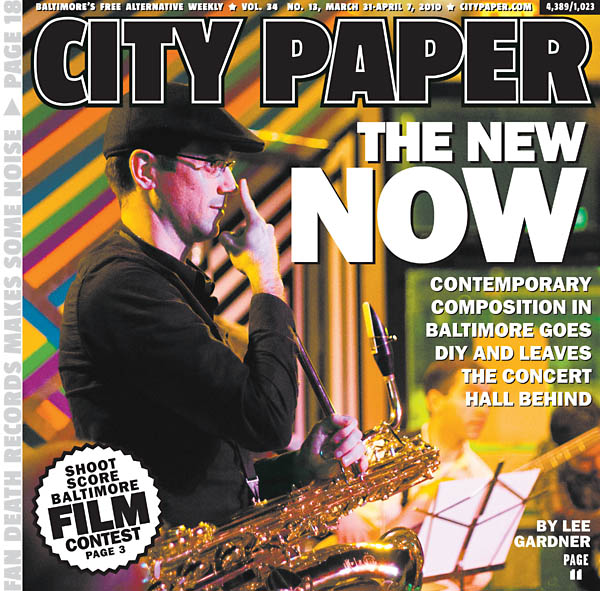Mind the Gap: March 2010 Archives
The whole "classical music to sell cars" trope is not news, but somehow the fact that a high-gloss coat of candy apple red backed by a drawing room-ready piece of piano noodling is still an effective way to move product fascinates me.* We should not ignore this pop culture fantasy, people! But, wait. Are we supposed to get off on the technical details? Oooohh, b flat major. Sounds positively scientific!
*More than that Lost episode did, at least.
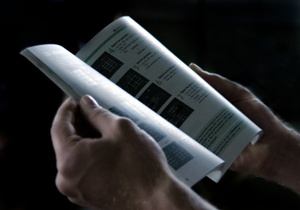 Maybe it's best to listen first and ask questions later when it comes to appreciating music? That's what a recent study published in the Psychology of Music journal seems to suggest. In "When program notes don't help: Music descriptions and enjoyment," Elizabeth Hellmuth Margulis (University of Arkansas) explores the reactions of non-musicians to samples of Beethoven string quartets. Those participants who listened without first wading through program notes found the experience more enjoyable. Margulis suggests that perhaps "when people without extensive formal training listen to music in terms of verbal descriptions, they may work so hard at connecting the notes into label-able phenomena that they lose the ability ... to hear the subtle interconnections among the sounds. These interconnections may be fundamental to music enjoyment." So much for "if you teach them, they will come."
Maybe it's best to listen first and ask questions later when it comes to appreciating music? That's what a recent study published in the Psychology of Music journal seems to suggest. In "When program notes don't help: Music descriptions and enjoyment," Elizabeth Hellmuth Margulis (University of Arkansas) explores the reactions of non-musicians to samples of Beethoven string quartets. Those participants who listened without first wading through program notes found the experience more enjoyable. Margulis suggests that perhaps "when people without extensive formal training listen to music in terms of verbal descriptions, they may work so hard at connecting the notes into label-able phenomena that they lose the ability ... to hear the subtle interconnections among the sounds. These interconnections may be fundamental to music enjoyment." So much for "if you teach them, they will come."
The study came across my desk via the new-to-me but very enlightening Miller-McCune website, and you can read more about Margulis's work there (as well as a great piece on David Cope's AI "composer"). Unless I'm actively researching a piece of music, I usually ignore the program or liner notes that accompany the auditory experience, at least at first. Like a child, I don't want to be told things. A new piece of music is an exciting thing, and I want to run off and explore the sound world being offered. Let me get inside and wander around a bit before making me sit and read an essay rooted in someone else's interpretation. Margulis is very cautious not to dismiss program notes as completely without merit, but reporter Tom Jacobs notes this tasty line from the report attributed to composer and musical theorist Leonard Meyer: "Listening to music intelligently is more like knowing how to ride a bicycle than knowing why a bicycle is ridable."
(If the intro music to this post was undeniably Pink Floyd, then the exit track is provided courtesy of Queen.)
Well, it certainly wasn't Grocery Store Musical...
...but the singers from the Washington National Opera's Young Artist Program had a little of their own fun in the produce section last week. True to the "we are all members of the media" times, it appears that there may have been as many cameras as people on hand to observe the action.
I've been seeing an unusual amount of cool music-meets-science news of late, but this video presentation of Marcus Coates' installation Dawn Chorus made the biggest splash in my birdbath by far. Seriously, the sounds alone left my mouth hanging open, but then check out the movements and the breath rate that's visible in the clips of each subject. On fast forward, it's as if these humans actually turn into super-sized birds.
(Click on the image to go to the full off-site video)
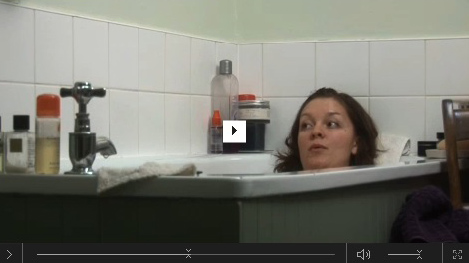
How did these people manage such amazing mimicry? Well, this being the 21st century and all, thankfully there's YouTube video to sate demands for more info. And, small world, the demonstration subject is none other than our favorite birdsong man, David Rothenberg.
More about the work:
During rigorous fieldwork 14 microphones were placed around woodland to record birds during one morning of birdsong in Northumberland. From this multi-track recording each song was slowed down up to 16 times, then human participants were filmed mimicking this slowed down song. Finally the resulting video footage was then speeded up, returning the bird mimicry into its 'real' register. The films are presented on screens in the gallery relative to the position of the birds when they were recorded. (Full text here)
Since I seem to be in a poetic mood this week, here's another delicate thing of beauty I stumbled across once again while wandering around on the internet.
This bit of stop-motion somnambulance has had plenty of play in the past year, but the artists are now selling off the pieces of this dream, image by image. Talk about memories that disperse through the intertubes and embed themselves in other people's lives.
Her Morning Elegance music video was made of exactly 2096 still photographs, shot and sequenced to create the sense of movement using stop motion technique. After going from stills to motion, the artists decided to break the motion back to its still form and exhibit the 2096 individual photographs in gallery exhibitions worldwide. Each still photograph will be printed once as a single edition print and sold through this website. Once a photograph is sold, the corresponding second in the video will no longer be available. And with the very last frame sold, the video will have been broken apart, back to its original 2096 pieces, spread worldwide and hung in 2096 houses, bedrooms, living rooms and galleries.
More about the project can be found here.
[via watching this and getting here and falling into this]
Whose unmade biopic would you want to see on the big screen?

We might be remembered forever. All our Twitter updates, our email, our Vimeo movies, our Xbox Live profiles, our wormy FourSquare maps. They won't be important. Not to most people, anyway. But they'll be there if the sysadmins take care of us, if the corporations and machines to whom we've entrusted our records do not fail or are not destroyed.
We won't matter to most. But our memories will be cataloged, indexed, made available along with our stories, our names...
If you didn't catch any of Gizmodo's Memory [Forever] series last week, it may be worth your peek now. I caught the above quote thanks to a boingboing mention and haven't been able to shake the concept since. How fragile most digital information seems to me. The intellectual output of an undergraduate education disappears in an electrical surge, volumes of letters vanish when an email account dies, albums of pictures evaporate when a registered pool goes unminded. In some ways, perhaps, our memories must lie in our minds more than ever now that we have 1000 vacation photos on a hard drive instead of 10 in a well worn coffee table album. Floods and fires, real and their digital equivalents, are ever present reminders of all we still can't carry with us no matter how vast yet portable our storage devices get.
You have more of your memories stored online than all of your ancestors ever left behind. The future of memory is already here...I didn't go to your party, but I saw 156 pictures of it on Facebook...
Still, the romantic in me wants to believe this kind of mapping is gaining ground: That several generations down, some interested great grandchild might be able to Google (or whatever the kids are doing then) a name and some relevant facts, and pour through pieces of lives lived long before they were breathing. Images, writing, music, art--personalities reflected in more facets than a smudged Polaroid and a few Christmas cards could ever offer.
Either reality seems frighteningly possible. So many memories could be preserved in all their unforgiving fullness or most of it could disappear in the march forward, the only remnants of a life left behind consisting of a dead Blackberry and what was scribbled on the backs of paper in the physical world--shopping lists tucked into coat pockets and receipts from the ATM slipped between the pages of books that were never finished.

I don't think I've mentioned this here before, but I am obsessed with This American Life. If Ira Glass called tomorrow to ask if I'd be the show's unpaid intern, I would be on a bus before the line went dead.
But seriously, what I love about this show, and what I want to learn to do better in my own media production, is how well they bring stories about the most average of people to bold, colorful life. (Their TV series was also great, but somehow their approach comes across even more vividly in the audio-only format.) Even when a particular episode sounds like it won't make an impression on me at all, it usually does anyway. Often it connects even more fiercely. For instance, I have listened to Sarah Vowell's contribution to episode 81: Guns (aired 10/24/1997) about four times now. You can check out her section, "NRA vs NEA," here. Just fast forward to the 4:08 mark if you want to get right to it. It runs about eleven minutes.
I was thinking again about the way TAL illuminates stories because I was at a concert last night and the program was hard and high. Kaija Saariaho, Jason Eckardt, Pierre Boulez. But part of what made this night work was that the performers were making some pretty fast connections with the crowd, saying just a few things about why they cared about these sounds and so, by extension, why we should. We were prepared for the music, but we also got this great glimpse into how they had prepared the music in the weeks and months prior to that moment and what made them tick as people. In particular, Katayoon Hodjati, a flute player who can't clock much over 5 ft. tall, stood between two huge pieces of poster board that were propped up on music stands and told us how Brian Ferneyhough's Casandra's Dream Song had turned into a kind of nightmare for her. For a while, she could only bear to deal with the music a line at a time and carried pieces of the carved up score around with her. When she worried that she wouldn't be able to read the music under the stage lights, she went to Kinkos and blew the pages up--they were huge--so she was sure not to miss the details.
Then she played, and for a little while at least, it felt like we were really sharing in the dream with her. It's likely as close as I will ever come to perfecting a Ferneyhough piece, and it made for an extra thrilling ride. But I've been wondering since how Ira Glass would have illuminated this story of solo musician, new music, difficulty, and fear. What would he have asked, and what would he take away? I have some reading to do.
Okay, kids, let's put our heads together. To save classical music, what viral video ploy would you use? (That is, of course, unless you think current classical music marketing is doing the job just fine the way it is, thank you very much.)
Yeah, I'm not being altogether serious, but a lot of viral videos do capitalize on some bit of musical, um, ingenuity. Two cases came across my desk this morning that seemed worth noting here in MTG, however. Instead of cats playing keyboards, hipsters playing with auto-tune, or ingratiating wordless Russian melodies getting jammed down our ears (accidentally!), these latest viral videos capitalize on freestyle piano improv and the classical music. Thought this could never be?
Yeah, me too. But just watch as a million stereotypes are piled on top of one another so that a string quartet can sell beer to 1,000 soccer fans...
On the night of the October 21st the Real Madrid played Champions League match against AC Milan. Heineken convinced several university professors, girlfriends, and several bosses to convince their students, boyfriends and employees to go to a concert on that night. All of them couldn't say no and had to go to the classical concert.
But...
[via Mashable]
Also...
Your host, Merton, freestyling in real-time with random strangers on Chat Roulette. No piano lessons, Merton is self-taught. Not Ben Folds. Seriously.
[via Waxy]
UPDATE: From the comments (thanks, Acheron!) Keep 'em coming, folks.
I went to hear the Baltimore Symphony Orchestra again last Thursday. I admit up front that I arrived completely ready to recant my earlier statement that I was loving orchestra concerts these days. I had half the blog post written in my head before I'd even found my seat in the hall. I mean, the idea just seemed soooo ridiculous.
Exhibit A:
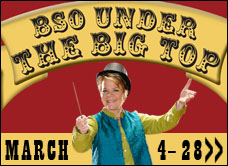
Right down to the cotton candy in the lobby, a treat that you would have to pry from your child's sticky grasp before entering the hall (No Food Please!), this operation seemed tragically misguided. I saw a clown and thought about that Lincoln Center poster.
However, I freely admit that I had it all wrong. It was AWESOME. I apologize for the pre-judgment.
Exhibit B:
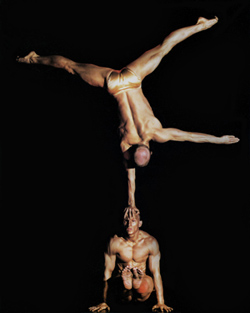
The program was Poulenc (Les Biches Suite), Bartók (Miraculous Mandarin Suite), Satie (Parade), and Copland (Billy the Kid Suite) featuring the BSO and performances by Cirque de la Symphonie, a troupe of very strong people with exceptional balance and flexibility. Think Cirque du Soleil but adjust the soundtrack and kill the production budget. No acrobats were used (or needed) to color the Mandarin story line, and honestly I could have done without them in the Copland as well. But wow, did they transform the experience of hearing the Poulenc and the Satie. I couldn't tell if the musicians were into it or if it was the most degrading night of their lives ever, but I did catch the concertmaster playing while staring up at an aerialist that was dangling from a rope high above Marin Alsop's head. I mean, yes, it was sometimes cheesy. And yes, it's a rentable performance that lots of orchestras are using (though based on some highly scientific YouTube research, it seems each ensemble picks its own music, and the BSO didn't skew lightweight). For once, an orchestra concert was as much gasp-inducing fun as was advertised. More, actually. There. I've said it. Thank god I wasn't hip to begin with.
But now that it's a couple days later, I wonder if the experience has changed my thinking about one-off shows that are friendly to new audiences, i.e. the video game music programs or the guest artist that goes over big with the Boomer set. The party line I always hear on that is that the shows are little more than bait-and-switch events that do not increase the local audience for normal concerts in the long term. Would that apply here as well? For a little while, at least, I'm going to be associating the Meyerhoff with a great night out, but now that I've had a few laughs and "did you see that!" moments, I'm actually looking for my next experience to be quite different. Just as compelling, but in a different way. Bring on the dark and twisty.
Oh, but before we go that direction, one more thing: Even more remarkable, considering Alex's recent talk and the blog-o-sphere chatter attending it, in one performance we solved the clapping issue! At the end of the first movement, no one knew what to do, but the idea of not acknowledging the grace and skill of the couple who had just three seconds earlier been flying through the air was just too ridiculous to manage. After that, we were home free, clapping like hoodlums whenever the emotion struck. Sure, we missed hearing a few notes. It was a live performance. We'll live. In fact, now we have a reason to go back so we can hear it again.
 Same friend (I know! She should start a blog, right?) passed me this link. Talk about dangling the cultural carrot. I think the boat ride to the island is my favorite part, though I wonder if this kind of "bragging rights" gimmick carries more cons than pros when it comes to the profile of the performing arts in society. Snob fest creator or innovative attention getter? Perplexingly, I like the audacity, even if it means I won't get to go.
Same friend (I know! She should start a blog, right?) passed me this link. Talk about dangling the cultural carrot. I think the boat ride to the island is my favorite part, though I wonder if this kind of "bragging rights" gimmick carries more cons than pros when it comes to the profile of the performing arts in society. Snob fest creator or innovative attention getter? Perplexingly, I like the audacity, even if it means I won't get to go.
Transposing the idea across art forms: Maybe classical music is actually too accessible. Do we need concerts every week? Maybe the musicians look bored for a reason. How do you maintain the idea that it's special when it's ubiquitous? In most communities, the music just exists in a building downtown. You can go there if you want, but there's really no fire burning under it to make you think you have to do it now. Premieres don't even generate that, though sometimes they garner a nice article in the local newspaper. But what if it was a much more unique and finely crafted affair? Fewer shows, but more considered presentations tailored to the music. Concerts would be events, not like when James Blunt fills your astrodome (no one have a heart attack) but similar to when an art museum gets some special limited run exhibit, all the walls get painted a new color, and suddenly you're immersed in Ancient Egypt or Rothko's color fields. Would the supply/demand axis shift? If nothing else, I feel like it would help me plug into the music with more focus and intensity.
Then, if we want to get really crazy, we could seriously jack the price. It may sound dumb, but so does the idea of a $10,000 handbag if you ask me, and those sell. Forget boats and islands. How about an evening of Mozart with food and clothes and location straight out of Amadeus (or Marie Antoinette, if that's your fancy)? The outreach conundrum would be solved; "under-served communities" would be ignored--intentionally! Yeah, we're probably pretty far away from that attitude adjustment. But if it comes, I'll take recitals performed as if we were shooting a scene for a Merchant Ivory film. Oh, and a complimentary ticket, please. Maybe Helena Bonham Carter will lend me a hat.
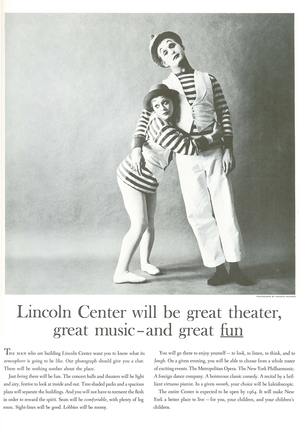 Some things, apparently, never change.
Some things, apparently, never change.
That image at right is from a 1960s ad campaign that was launched to both raise funds and gather public support for the construction of Lincoln Center.
A friend passed it my way, and I post it here because a lot of ideas floating by me of late re: "How do you solve a problem like the state of the [insert institutional performing art form] industry?" are summarized with just a glance at that slogan. Talk about "something doesn't smell quite right about this" advertising. It's like It but with mimes. Fun is kind of the last emotion it raises. But fun is also not generally what I'm looking for when I go to a performance, at least not in the candy colored amusement park sense that seems to be implied here. Maybe I'm just too insider-y and jaded. Did this campaign work back then? Would it work with any demographic out there today?
Bait and switch, water down, make friendly: why go this route? A night at the symphony is not a night at the circus (well, except when it is). I can't believe it's that there aren't enough creative ideas out there when it comes to slick, sophisticated, evolutionary ways of presenting "classical" or "concert" or whatever you want to call the field of music that gets all those government and foundation dollars and so needs to be sure to maintain a certain level of public interest. If nothing else, I read about them on blogs all the time. But getting to the part where we enact change is as frustrating as watching C-SPAN (though here again I fully acknowledge that my own nose might be pushed just a bit too hard against the glass). Truly, it feels like the industry has turned into a kind of political party paralyzed by tradition and bureaucracy. I mean, it's 2010 and in his lecture to the Royal Philharmonic Society, Alex Ross had to spend many (many!) words on the clapping issue. The clapping issue! We often know perfectly well what's broken, but will we ever be able to drag significant solutions through in a bold and timely fashion?
Later, Ross did get to speak a bit about the experience of taking friends to classical music concerts and registering that otherwise culturally engaged people leave disappointed and that "the evening in some way falls short." In my experience, this is exactly the case. We dedicated concert goers arrive at the hall not expecting a "show" or the kind of spectacle most ticketed experiences deliver as a matter of course. Remember how much fun you had at that Bare Naked Ladies show in 1996? This is not that. No, instead we understand going in that at best we'll get something on par with a good lecture at the public library or a not terribly well-designed black box theater production. We attend as if it's a religious service because we can take enough joy from hearing this type of music played live to adequately recoup our investment. However, that's not how increasingly larger groups of people want to spend $40 and a Saturday night. So we can either downsize with a smile, or tweak till we catch up in the numbers game, but even the Smithsonian museum didn't rely on displaying those dusty dioramas forever.
Sure, there are groups at the fringe doing crazy things right now that blow up (success!) or blow up (clearly no one thought that through!). They take their passion and place their bets. Still, if all those conferences are in any way a reliable reflection of the arts institutions out there, they've largely been blinkered and sucked down into a tide pool of exhaustion and fear so forcefully that current economics may be the final straw for some. So unless a hero with super human strength comes by with some pretty strong rope, would the music be better served outside these monolithic institutional structures? I suspect groups that are much more flexible and capable of steady experimentation and rapid change are vital today more than ever, because money is tight, audiences are distracted, and I doubt the answer is one singular sensation in a time gone global.
Now, now, I know what you're thinking. And I can't show you the money. The monoliths with the track records have what's left of it. So what to do?
(Now, completely unrelated funny video as reward for reading that entire post.)
In response to the jewelry heist, Vijay put out a new music remixing/response challenge and I was inspired. So this weekend I thought hard and gathered some video and sound materials and...failed completely to rise to the occasion. Despite what the naysayers suggest, in my limited experience this kind of work requires amazing skill and creativity, and I'm just not there yet. (Though the exercise wasn't a complete wash. I now have a file folder filled with CSI Miami quotes, Law and Order sound effects, and the theme song from COPS, which I hope will come in handy one day.)
While I was procrastinating, however, the Pantless Knights posted this brilliant spoof/tribute to the "new dorks" spun off from the Jay-Z and Alicia Keys track "Empire State of Mind," and I am once again inspired. It's addictive; you have been warned.
It's almost time again for sparkly dresses, borrowed jewelry, and the disbursement of those little gold men! I'm not usually knowledgeable enough to play the office Oscar pool, but somehow this year I got to watching quite a few of the entries shortlisted in the "best animated short" category. Lots of inventive stuff in this parade, but I ended up falling for one that didn't make the final nominee cut. It has music and cats, however, (also Nick Cave) so I thought I might give it a little love here on the internet. Plus! 8 minutes, no speeches.
Learn more about the animators behind the film here.
